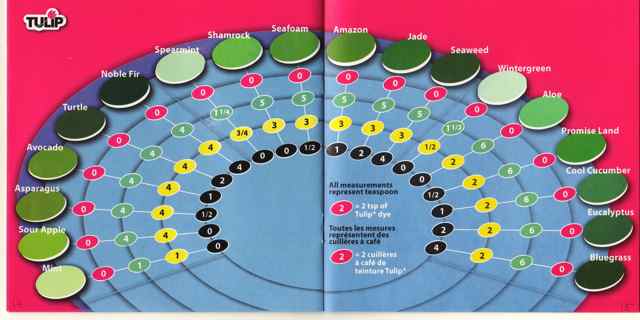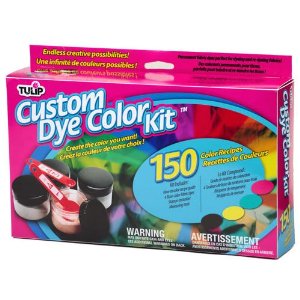What's the best way to custom dye a specific color?
What's the best way to custom dye a specific color?
Name: Brian
Country or region: Virginia, USA
Message: Hi. I am building sets for playing the game "Cornhole", where you toss corn-filled duck-cloth bags at wooden boards. I'm currently experimenting with custom-built sets, for example, a Green Bay Packers-themed set for a friend. I think I've got paint colors for the BOARDS down, but I would also like to create custom-colored corn bags to go along with the boards. At least where I shop for duck cloth, it comes in a very limited range of colors. I can get basic yellow and basic green, but I'd like to go a step beyond that and have bags with the OFFICIAL Green Bay Packers colors.
The material I'll be using is white duck cloth (unless you think I'd be better off starting with a different color). I've read a little bit on your very informative website, and I understand the difference between fiber-reactive dyes and direct dyes, but since these corn-bags will never be washed, I'm thinking I'll be ok with the direct dyes.
I'm assuming that, if I buy all of the basic colors of a given brand of direct dyes, that I can mix them, in different proportions, to achieve pretty much any color I want. But is there some source, or some website, that will tell me EXACTLY how much of each basic color is needed to achieve a given color? Actually, I'd like to be a little more specific than "hunter green" or "taxi-cab yellow" (Green Bay's official colors) and plug in the RGB values for the final colors I want and have it tell me exactly how much of each basic color to use. Does something like that exist? Preferably online?
An important warning: watch out when you buy your duck cloth. Duck describes a weave, not what it's made of. You must be sure what the fiber content is, before you buy it. You don't want to bother with dyeing a polyester duck, since dyeing polyester is far, far more trouble than dyeing cotton is. Look for a 100% cotton (or other natural fiber), one which has not been treated to make it permanent press, since the permanent press coating interferes with dyeing. For the most intense colors, look for mercerized cotton, which has been treated with lye so that it dyes better.
There is a commercially available set of hot-water fiber reactive dyes in a kit designed just for color mixing, the Tulip Custom Color Kit. It contains a color brochure with recipes for 150 different colors, across the entire spectrum. Five of the little pages are devoted entirely to shades of green. For example, here's an image of pages 14 and 15 [click to see a larger copy]:

The numbers in the circles in the picture refer to how much of each of the four dye colors included in the kit to use. For the color described as 'Jade", they say to use 2 teaspoons of black, 3 teaspoons of yellow, 5 teaspoons of turquoise, and no red at all, for each half-pound of cotton fabric. This kit appears to be exactly what you want, and it's a very reasonable investment (list price under $30), though it is more expensive than similar quantities of Procion MX dye by mail-order. What you're really paying for is their having worked out all of the different color mixtures; since different dyes vary, the recipes cannot be expected to work for any other brand of dye. Since the dyes in it are fiber reactive dyes, their washfastness should even be very good, though you don't care about that. However, I have not tested the Tulip Custom Color Kit for myself, so I can't evaluate how closely the colors produced by the kit will correspond to the colors in the brochure. Of course, the accuracy of the colors produced will always vary somewhat according to the individual dyer's circumstances. If you decide to try the Tulip Custom Color Kit, please let me know how you like it!
The Tulip Custom Color kit is far from being your only option for obtaining the exact colors you want. Jacquard Products provides a good color mixing chart for their Procion MX dyes. For this and other color-mixing charts for Procion MX dyes, see the following page: "How can I mix Procion MX dyes to get specific colors?". For the widest selection of different pre-mixed colors of Procion MX dyes, see Dharma Trading Company and PRO Chemical & Dye, which each have something like one hundred different colors (all mixed from less than a dozen different pure dyes). Jacquard Products sells 43 different colors of Procion MX dyes, including seven different greens. For contact information and links for these and other dye suppliers, see my page, Sources for Dyeing Supplies Around the World.
One brand of direct dye, the Jacquard iDye line of direct dyes, gets better approval ratings than all purpose dyes such as Rit, which contain a mixture of direct and acid dyes. Unfortunately, Jacquard Products does not provide a color mixing chart for their iDye line of dyes, so I don't recommend them for your situation, unless the colors available happen to include all of the colors you want.
Rit All-Purpose dye is available in 26 colors, including three greens, but the company that makes Rit dye also provides a mixing guide, which they call the COLORit Color Formula Guide. You can also view the old Rit Custom Color Recipes online, though the colors may or may not all be possible to replicate, depending on how many of the color formulas have changed. I do often hear complaints that Rit dyes, as purchased, produce colors other than expected, possibly because of the fact that some of the dyes invariably wash out of any fabric you color; the acid dyes in Rit will wash out of cotton, while, in most cases, the direct dyes in Rit will wash out of protein fibers. Even though you will not be washing your game bags routinely, you must wash them after you apply the dye, in order to remove any loose unattached dye.
If you will be buying a large quantity of a dye color, some dye companies will be happy to custom blend a dye to meet your needs, but the minimum order would be at least five pounds of dye, a vast excess compared to your needs for this project.
The RGB values used for displaying colors with light, as on computer monitors, do not translate well to the CMYK values used for mixing print inks and fabric dyes, because the two systems work in very different ways. For example, if you mix red plus green on a computer monitor, you will get yellow, but if you mix red plus green dyes, you will get a muddy brown color. My favorite way to work out color mixtures before even getting out the dyes is to look at Olli Niemitalo's Dye Mixer Applet. However, it's not a source of recipes; it cannot tell you exactly how much of any dye to use, unless you first work out how much dye it takes to get each of the individual colors.
Every one of these sources of color mixing information, without exception, can provide no more than a general guide. This is true even for the color shown on the box or jar of dye you buy, even if you're not mixing your own colors. The color you produce may vary, depending on many details such as the lot of each dye that you buy, the exact amount of each dye you measure out, the specific bolt of fabric you are coloring, the chemical content of your local water supply, the temperature at which you do your dyeing, and on and on. You MUST do a test, for every single color, in order to be sure you can produce the right color. This is equally true whether you buy a pre-mixed color, of any type, or if you are mixing your own from two or more other colors. It is impossible for any dye company to print a color swatch that the customer will be able to reproduce 100% of the time. Keep careful notes of how much dye powder and other chemicals you use (such as washing soda or salt), the temperature of your water, how much each piece of fabric you dye weighs, and so forth. If you do not get the color you want immediately, trial and error, and more advice as needed, will eventually make it possible for you to obtain any color you want.
So, in conclusion, I would recommend that you buy either the Tulip Custom Color Kit, or several colors of Procion MX dyes (plus soda ash and salt), and a lot more 100% cotton fabric than you think you will need, so you'll have enough for several attempts at each color. Alternatively, you can give the Rit dye mixing charts a try, since washfastness does not matter to you, but only if the colors in the Rit color charts look good for your projects.
Posted: Monday - December 06, 2010 at 08:28 AM
Follow this blog on twitter here.
Quick Links
- All About Dyes & Dyeing Top -
- Top of this blog -
- FAQ -
- The Dye Forum -
- How to Tie Dye - How to Batik -
- Books - Toys - Plants -
- Top of this blog -
- FAQ -
- The Dye Forum -
- How to Tie Dye - How to Batik -
- Books - Toys - Plants -
More in this category:
- -
Statistics
Total entries in this blog:
Total entries in this category:
Published On: Aug 29, 2012 02:49 PM
Total entries in this category:
Published On: Aug 29, 2012 02:49 PM
